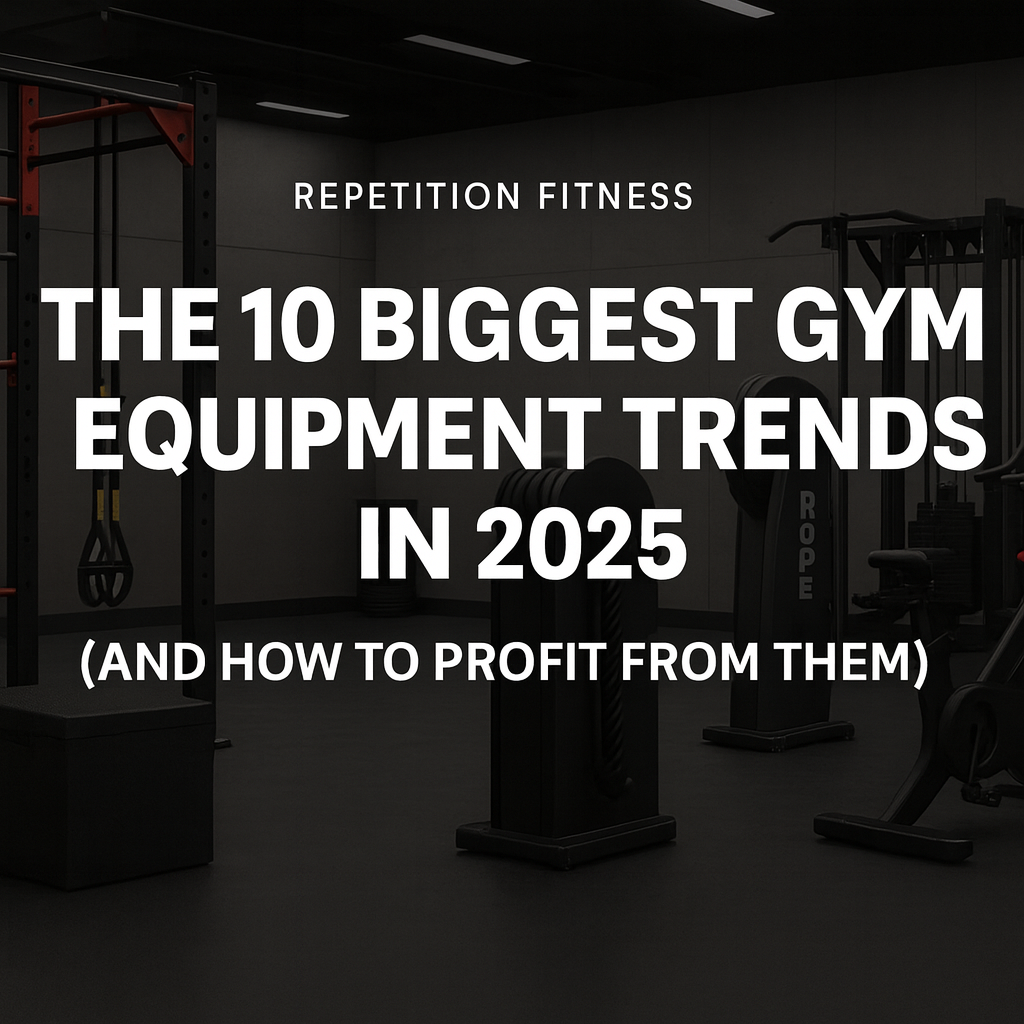The 10 Biggest Gym Equipment Trends in 2025 (And How to Profit From Them)

Why Gym Equipment Trends Matter in 2025
The fitness industry is evolving faster than ever, and staying ahead of the curve has never been more important. Gyms that invest in modern equipment will attract members, increase retention, and ultimately drive more revenue, while facilities that stick to outdated machines risk falling behind. In 2025, the strongest trends center around functional training, connected technology, and space-efficient multi-use solutions. These aren’t passing fads—they represent a shift in how people want to train, blending performance, engagement, and innovation.
Functional Training Takes Center Stage
One of the biggest shifts this year is the rise of functional training systems. Instead of filling a gym floor with bulky single-use machines, more facilities are adopting multi-station rigs and modular platforms that combine cables, suspension systems, and bodyweight tools. These setups allow members to move naturally, train in groups, and flow seamlessly from one exercise to the next. For gyms, this means more efficient use of space and the ability to offer premium small-group classes. A system like the SHAPE-X Four Station embodies this trend perfectly—allowing multiple users to train simultaneously while supporting a wide range of exercise styles.
Rope Training Gains Traction
Rope training machines are quickly becoming a staple in performance gyms, tactical facilities, and sports training centers. Unlike traditional cardio or strength machines, rope trainers engage the full body with continuous pulling resistance that builds grip strength, endurance, and explosive power. They’re low-maintenance, compact, and versatile enough for athletes, firefighters, and anyone looking to develop functional strength. The Ropeflex RX550 is a great example of how rope training equipment delivers powerful results while remaining space-efficient.
Connected Cardio Redefines the Experience
Cardio equipment is no longer about logging miles on a treadmill or riding a standard spin bike. Members now expect immersive experiences with screens, data tracking, and app integration. From guided classes to real-time performance metrics, connected cardio machines keep users engaged and motivated. The CHRONO® StudioConnect™ bike is a prime example of this evolution, offering a large touchscreen, precision power tracking, and virtual class integration. For gyms, adding connected cardio isn’t just about upgrading equipment—it’s about elevating the entire member experience.
Space-Saving Multi-Gyms
Another major trend in 2025 is the demand for compact multi-gyms. As urban gyms, boutique studios, and residential fitness centers continue to grow, space efficiency has become critical. These multi-station machines deliver full-body workouts in a fraction of the space, replacing the need for multiple isolated machines. For hotels, condos, and corporate gyms, compact designs allow facilities to offer high-value training options without overcrowding the floor.
Recovery Becomes Non-Negotiable
Gyms are no longer just training spaces—they’re recovery hubs too. Facilities are now investing in massage guns, stretching systems, and percussion therapy tools to give members a complete fitness experience. Recovery equipment not only reduces injuries and improves performance but also differentiates a gym from its competitors. Members increasingly expect to see recovery zones alongside cardio and strength areas, making this a valuable upgrade for retention and satisfaction.
Smarter Strength Training
Strength equipment is also going high-tech. In 2025, smart weight systems and connected resistance machines are helping members lift more efficiently by providing real-time feedback on form, tempo, and workload. This kind of guidance reduces injury risk while making strength training accessible to beginners. For athletes, it allows precise tracking and progressive overload. The result is a smarter, safer, and more personalized approach to strength development.
The Rise of Group Training Rigs
Community-driven workouts remain one of the most powerful retention tools for gyms, and group training rigs are fueling this demand. Multi-user stations designed for HIIT, boxing, and circuit training create an atmosphere of motivation and accountability. Trainers benefit too, as these rigs make it easier to coach multiple clients at once. For gyms, this means higher class capacity and the opportunity to introduce new premium training programs that generate additional revenue.
Wearable Tech Meets Equipment
Wearable fitness technology has been around for years, but in 2025, members expect their devices to integrate directly with gym equipment. Heart-rate monitors, smartwatches, and performance trackers now sync seamlessly with cardio and strength machines, creating a data-rich training environment. This integration enhances engagement, allows trainers to design smarter programs, and keeps members accountable to their goals—all of which drive retention.
Eco-Friendly Fitness Takes Hold
Sustainability has become a top priority for gyms and members alike. Self-powered cardio machines, recycled materials, and eco-conscious designs are becoming the norm. Not only do these machines reduce energy costs, but they also align with the values of environmentally conscious members. Gyms that invest in eco-friendly equipment stand out as modern, forward-thinking, and socially responsible.
Hybrid Fitness for Home and Commercial Use
Finally, the line between home fitness and commercial gyms continues to blur. Many people still want the convenience of home training, while gyms remain a hub for community and variety. Equipment that works in both environments—like high-end spin bikes, compact cable trainers, and portable functional tools—is in high demand. For gyms, offering hybrid solutions creates opportunities for corporate partnerships, luxury memberships, and added revenue streams.
How Gym Owners Can Capitalize on These Trends
These trends aren’t just about keeping up appearances—they’re about profitability. Modern equipment attracts new members, keeps current ones engaged, and opens new revenue opportunities through group training, recovery services, and premium memberships. By investing in functional, connected, and eco-conscious solutions, gyms can increase retention, improve member satisfaction, and future-proof their facilities for years to come.
Final Thoughts: The Future of Gym Equipment in 2025
The gyms that thrive in 2025 won’t necessarily be the ones with the most machines—they’ll be the ones that choose the right machines. By focusing on functional rigs, rope trainers, connected cardio, and smart strength equipment, facilities can deliver results, maximize space, and provide an engaging member experience. Recovery, sustainability, and hybrid flexibility round out the trends that are shaping the industry.
Whether you’re running a large commercial facility, a boutique studio, or building a luxury home gym, these equipment trends represent the future of fitness. The key is acting now—adopting these innovations before your competitors do.
At Repetition Fitness, we specialize in helping gyms and individuals upgrade with equipment that aligns perfectly with these 2025 trends. The future of fitness is here—are you ready to lead it?


